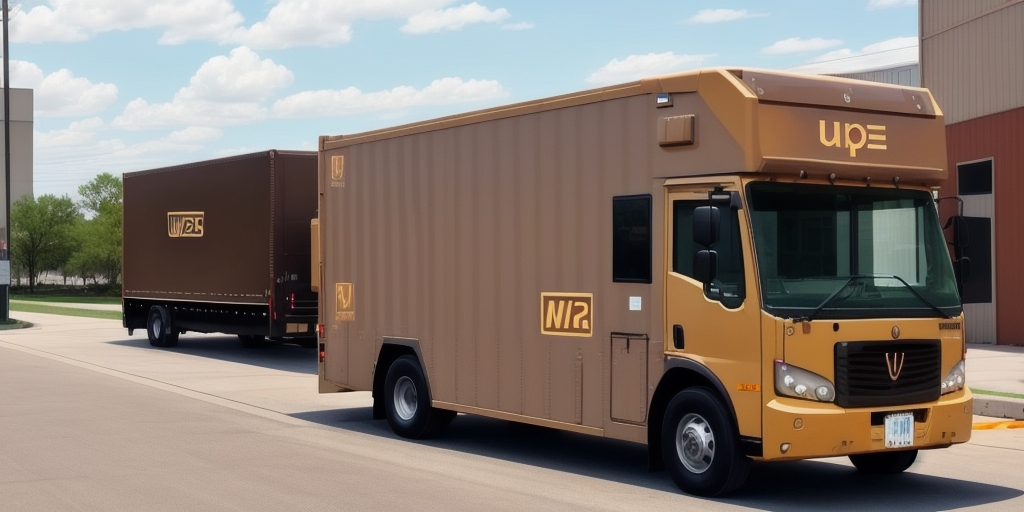Understanding UPS Shipping Rates in Texas
In today's fast-paced business environment, delivering products to customers swiftly and efficiently is crucial. United Parcel Service (UPS) is a trusted shipping provider that offers a variety of services at competitive rates. For business owners in Texas, understanding UPS shipping rates is essential to optimize shipments and reduce costs. This article delves into the key aspects of UPS shipping rates in Texas, providing insights and strategies to enhance your shipping process.
Why UPS is a Reliable Shipping Option for Businesses in Texas
With over a century of experience, UPS has built a reputation as a reliable and trustworthy shipping provider. Operating in more than 220 countries and territories, UPS's extensive network of transportation assets ensures prompt and efficient delivery of packages across the globe. In Texas, UPS's local infrastructure includes a robust fleet of trucks, planes, and delivery vehicles, accommodating the diverse needs of businesses.
Moreover, UPS offers a wide array of shipping options, ranging from standard ground shipping to expedited air services. This flexibility allows businesses to select the most appropriate shipping method based on urgency, budget, and customer expectations.
UPS's advanced tracking system is another cornerstone of its reliability. Businesses can monitor their shipments in real-time from pickup to delivery, enabling them to manage their supply chain proactively and keep customers informed.
In addition to shipping services, UPS provides value-added solutions such as packaging and labeling services, customs brokerage for international shipments, and supply chain management tools, enhancing overall operational efficiency for businesses in Texas. For more information, visit the UPS shipping services.
Factors That Affect UPS Shipping Rates in Texas
UPS shipping rates are influenced by several factors, including package weight, dimensions, destination, and chosen shipping method. For instance, shipping a compact, lightweight item within Dallas via standard ground shipping will cost less than shipping a large, heavy item to a remote area using expedited air service.
Additional surcharges may apply for services such as residential delivery, delivery to remote locations, or requiring special handling. Seasonal fluctuations, such as increased demand during the holiday season, can also impact shipping rates. Businesses should be mindful of these variables to accurately estimate shipping costs and adjust their logistics strategies accordingly.
- Package Weight and Dimensions: Heavier and larger packages incur higher shipping costs due to increased fuel consumption and space utilization.
- Destination: Longer distances and deliveries to remote or rural areas typically result in higher rates.
- Shipping Method: Faster delivery options, such as expedited air services, cost more than standard ground shipping.
- Additional Services: Services like insurance, signature confirmation, and special handling add to the overall cost.
- Seasonal Demand: Peak seasons may see higher rates due to increased shipping volumes.
To get an accurate shipping quote from UPS, it's vital to consider all these factors and input precise shipment details into the rate calculator.
How to Calculate UPS Shipping Rates in Texas
Calculating UPS shipping rates in Texas is straightforward using the UPS online shipping calculator, which considers package weight, dimensions, destination, and the selected shipping service. Here's a step-by-step guide:
- Visit the UPS Rate Calculator.
- Enter the shipment's origin and destination addresses.
- Provide the package's weight and dimensions.
- Select the desired shipping service (e.g., Ground, 2nd Day Air, Overnight).
- Review the estimated shipping costs and any applicable surcharges.
Alternatively, businesses can contact UPS customer service or use a third-party shipping calculator for estimates. Ensuring accurate and detailed shipment information is crucial for obtaining precise quotes.
For bulk shipments, leveraging UPS's business solutions or partnering with a third-party logistics provider (3PL) can help negotiate better rates and streamline the shipping process.
Understanding the Different Types of UPS Shipping Services Available in Texas
UPS offers a comprehensive suite of shipping services tailored to meet the diverse needs of businesses in Texas:
- UPS Ground: The most economical option for domestic shipments, offering reliable delivery within 1-5 business days.
- UPS 3 Day Select: Guarantees delivery within three business days, providing a balance between cost and speed.
- UPS 2nd Day Air: Ensures delivery by the end of the second business day, ideal for time-sensitive shipments.
- UPS Next Day Air: Provides next-business-day delivery, catering to urgent deliveries.
- UPS International Shipping: Enables businesses to ship globally with services like UPS Worldwide Express and UPS Worldwide Expedited, including customs brokerage and international tracking.
- UPS Freight: Offers less-than-truckload (LTL) and full truckload (FTL) freight services for larger shipments.
Each service option varies in terms of delivery speed, cost, and included features. Selecting the appropriate service depends on the specific requirements of the shipment, such as delivery timeframe and budget constraints.
For a detailed overview of UPS services, visit the UPS services page.
Tips for Saving Money on UPS Shipping Rates in Texas
Businesses in Texas can implement several strategies to reduce their UPS shipping costs:
- Leverage Volume Discounts: UPS offers discounted rates for businesses that ship frequently or in large volumes. Enrolling in UPS Business Solutions can unlock these savings.
- Optimize Packaging: Efficient packaging can minimize package dimensions and weight, leading to lower shipping costs. Using lightweight materials and eliminating unnecessary space within packages can contribute significantly.
- Choose Suitable Shipping Options: Selecting the most cost-effective shipping method that meets delivery deadlines can reduce expenses. For non-urgent shipments, opting for ground shipping instead of expedited services can result in substantial savings.
- Negotiate Rates: Regular shippers can negotiate better rates with UPS, especially if they have a consistent shipping volume. Building a strong relationship with a UPS account manager can facilitate this process.
- Use Technology Solutions: Utilizing shipping software and integrating UPS's online tools can help streamline operations and identify cost-saving opportunities.
- Consolidate Shipments: Combining multiple shipments into a single package can reduce the overall cost per shipment.
Implementing these strategies can lead to significant cost savings and enhance operational efficiency.
For more tips on optimizing shipping rates, explore resources such as the ShipScience blog.
The Benefits of Using UPS for Shipping in Texas
Choosing UPS as your shipping provider in Texas offers numerous benefits:
- Reliability: UPS's extensive network and robust infrastructure ensure timely and consistent deliveries.
- Comprehensive Service Options: From standard to expedited shipping, UPS provides a range of services to meet various business needs.
- Advanced Tracking: Real-time tracking allows businesses to monitor shipments and manage their supply chain effectively.
- Global Reach: UPS's international services enable businesses to expand their reach and serve a global customer base.
- Value-Added Services: Services such as packaging, labeling, and customs brokerage enhance operational efficiency.
- Discounted Rates for Businesses: UPS offers competitive rates and discounts for businesses that ship regularly.
- Customer Support: Dedicated customer service helps address shipping-related concerns promptly and efficiently.
These advantages make UPS a preferred choice for businesses in Texas seeking reliable and cost-effective shipping solutions.
Learn more about the benefits of UPS services on the UPS website.
How to Get Accurate Quotes for Your UPS Shipments in Texas
Obtaining accurate quotes for UPS shipments is essential for effective budgeting and logistics planning. Here’s how to ensure precise rate estimations:
- Use the UPS Shipping Calculator: The official UPS online rate calculator allows you to input precise shipment details to receive accurate quotes.
- Provide Detailed Shipment Information: Accurate measurements of package dimensions, weight, and destination ensure the quote reflects the actual shipping costs.
- Consider All Factors: Include potential surcharges, additional services, and any special handling requirements in your calculations.
- Contact UPS Sales Representatives: For large or complex shipments, consulting with a UPS sales representative can provide customized rate quotes and potential discounts.
- Use Third-Party Shipping Software: Shipping management software can integrate with UPS to automate quote generation and compare rates across different services.
- Partner with a Third-Party Logistics Provider (3PL): A 3PL can negotiate rates on your behalf and optimize your shipping strategy for cost-efficiency.
Ensuring the accuracy of your shipment details and leveraging available tools and resources will help you obtain the most precise UPS shipping quotes.
Common Mistakes to Avoid When Using UPS for Shipping in Texas
When utilizing UPS for shipping in Texas, avoiding common pitfalls can prevent unexpected costs and delays. Here are some mistakes businesses should steer clear of:
- Incorrect Shipment Information: Providing inaccurate package weight, dimensions, or destination can lead to incorrect billing, delays, or surcharges. Always double-check shipment details before processing.
- Poor Packaging: Inadequate packaging can result in damaged goods, returns, and additional costs. Use appropriate packaging materials and follow UPS packaging guidelines to ensure safe transit.
- Ignoring Rate-Break Points: Not understanding how UPS's rate structures work can lead to overpaying. Familiarize yourself with rate-break points to optimize shipping costs.
- Failure to Use Tracking: Not utilizing UPS's tracking capabilities can hinder supply chain visibility and customer communication. Always track shipments to manage expectations effectively.
- Not Considering Insurance: For valuable or fragile items, neglecting to purchase insurance can result in significant losses in case of damage or loss.
- Overlooking UPS Resources: UPS provides numerous tools and resources to assist with shipping management. Failing to utilize these can result in inefficiencies and higher costs.
By being aware of and avoiding these common mistakes, businesses can enhance their shipping processes and reduce associated risks and costs.
Understanding the Delivery Times and Guarantees of UPS Shipping in Texas
UPS offers various delivery guarantees that ensure shipments arrive within specified timeframes. These guarantees vary based on the selected shipping service:
- UPS Ground: Delivery typically within 1-5 business days, depending on distance and destination.
- UPS 2nd Day Air: Delivery by the end of the second business day, applicable to most destinations.
- UPS Next Day Air: Guarantees next-business-day delivery, ideal for urgent shipments.
- UPS Worldwide Express: International service with delivery by the next business day to major business centers.
If UPS fails to meet the guaranteed delivery date, they offer a refund for the shipping costs for that particular service, adhering to their Satisfaction Guarantees.
However, delivery guarantees may not apply in certain circumstances, such as extreme weather events, natural disasters, or other unforeseen disruptions. It’s important for businesses to be aware of these conditions and plan accordingly.
For detailed information on UPS delivery guarantees, visit the UPS Service Guarantees.
How to Track Your UPS Shipments in Texas
Tracking UPS shipments in Texas is simple and provides real-time visibility into the status of your packages:
- UPS Website: Visit the UPS Tracking page and enter your tracking number to view the current status and history of your shipment.
- UPS Mobile App: The UPS mobile app offers tracking capabilities, allowing you to monitor shipments on the go, receive notifications, and manage deliveries from your smartphone.
- Email and SMS Notifications: Sign up for automated notifications to receive updates on your shipment’s progress via email or text message.
- Contact UPS Customer Service: For additional support or detailed inquiries, reach out to UPS customer service representatives.
Utilizing these tracking tools enhances supply chain visibility, improves customer communication, and helps businesses manage their logistics more effectively.
Learn more about tracking options on the UPS Tracking and Alerts page.
Comparison of UPS with Other Shipping Carriers Operating in Texas
When choosing a shipping carrier in Texas, it's important to compare different providers to determine the best fit for your business needs. The primary competitors to UPS in Texas include FedEx, USPS, and DHL.
Here’s a comparison overview:
- UPS: Known for its extensive global network, reliable delivery times, and comprehensive tracking system. UPS offers a wide range of services catering to various business needs.
- FedEx: Offers strong overnight shipping options and robust international services. FedEx is often preferred for time-sensitive shipments.
- USPS: The United States Postal Service provides economical options for small packages and residential deliveries, with extensive reach across all U.S. locations.
- DHL: Specializes in international shipping, offering a strong global presence and expertise in customs clearance.
Each carrier has its strengths: UPS excels in reliability and comprehensive service offerings, FedEx in expedited shipping, USPS in cost-effective small parcel delivery, and DHL in international expertise. Businesses should evaluate their specific needs, such as delivery speed, cost, package size, and destination, to choose the most appropriate shipping carrier.
For an in-depth comparison of shipping carriers, refer to the ShipScience comparison.
The Impact of Distance on UPS Shipping Rates within Texas
Distance is a critical determinant of UPS shipping rates in Texas. Shipping a package over short distances within urban areas like Houston or Dallas will generally be less costly than sending it to remote locations such as West Texas or rural communities.
Additionally, shipping from Texas to other states or internationally increases costs due to the longer transit distance and additional logistical requirements. UPS calculates shipping rates based on the zone system, where higher zones correspond to greater distances and hence higher rates. Understanding the zone structure can help businesses estimate shipping costs more accurately.
For intra-state shipping, consolidating shipments to cover shorter distances or strategically locating distribution centers can mitigate the impact of distance on shipping rates.
To explore zone-based pricing and its effect on shipping rates, visit the UPS Zone Pricing FAQ.
Understanding the Role of Insurance and Packaging on UPS Shipping Rates in Texas
Proper insurance and packaging play significant roles in managing UPS shipping rates and protecting shipments:
- Insurance: UPS offers shipment insurance options to cover the value of goods in case of loss or damage during transit. While adding insurance increases shipping costs, it provides financial protection for valuable or fragile items.
- Packaging: Efficient and secure packaging reduces the risk of damage, which can prevent additional costs related to claims or returns. Using appropriately sized boxes, padding materials, and adhering to UPS's packaging guidelines ensures safe delivery and can help minimize package weight and dimensions, thereby reducing shipping rates.
Investing in quality packaging and considering shipment insurance are essential practices for managing shipping costs and safeguarding business assets.
For more details on UPS insurance and packaging guidelines, refer to the UPS Packaging and Insurance page.
Best Practices for Effective Communication with Your Customers During the Shipping Process Using UPS Services in Texas
Effective communication during the shipping process fosters trust and enhances customer satisfaction. Here are best practices for businesses using UPS services in Texas:
- Provide Clear Tracking Information: Share UPS tracking numbers with customers to allow them to monitor their shipment's progress in real-time.
- Set Accurate Delivery Expectations: Clearly communicate estimated delivery dates based on the chosen UPS service, ensuring customers know when to expect their orders.
- Notify Customers of Delays: In cases of unexpected delays, proactively inform customers and provide updated delivery estimates to manage their expectations.
- Use Automated Notifications: Implement automated systems to send shipping confirmations, tracking updates, and delivery confirmations to customers.
- Offer Multiple Communication Channels: Enable customers to reach out via email, phone, or chat with shipping-related inquiries, ensuring accessibility and responsiveness.
- Provide Comprehensive Shipping Policies: Clearly outline shipping terms, return policies, and any additional fees on your website to prevent confusion and set expectations upfront.
Adhering to these communication practices not only improves customer experience but also minimizes potential issues related to shipping.
How to Handle Delays, Shortages, and Damages During the Shipping Process with Help from UPS Services in Texas
Despite UPS's reliability, delays, shortages, and damages can occasionally occur. Here's how businesses can effectively handle such issues:
- Delays:
- Monitor shipments in real-time using UPS tracking tools.
- Communicate promptly with customers about delays, providing revised delivery estimates.
- Investigate the cause of delay by contacting UPS customer service for resolution.
- Shortages:
- Verify shipment contents against the shipping manifest before dispatch.
- Report any discrepancies to UPS immediately for investigation.
- Damages:
- Inspect packages upon arrival and document any visible damages.
- File a damage claim with UPS promptly, providing necessary evidence and documentation.
- Coordinate with UPS to ensure reimbursement or replacement of damaged goods.
Implementing preventive measures such as robust packaging and accurate documentation can reduce the occurrence of these issues. Additionally, maintaining open lines of communication with UPS and customers ensures swift resolution and maintains trust.
Understanding a Breakdown of Different Surcharges Associated with Using the Various Services Offered by UPS within the State of Texas
UPS imposes various surcharges based on the selected services and specific shipment requirements in Texas. Understanding these surcharges is essential for accurate cost estimation:
- Residential Delivery Surcharge: Applies when delivering to a residential address instead of a business location.
- Fuel Surcharge: A variable charge that fluctuates with fuel prices, reflecting the cost of fuel consumption during transportation.
- Remote Area Surcharge: Applies when delivering to locations outside of major urban centers, where additional travel time and resources are required.
- Saturday Delivery Surcharge: For shipments requiring delivery on Saturday, an additional fee is applied.
- Liftgate Service Surcharge: Applies when a liftgate is needed at the pickup or delivery location to handle heavy or bulky items.
- Declared Value: Additional charges apply when declaring a higher value for the shipment beyond the standard liability coverage.
Understanding each surcharge helps businesses incorporate these costs into their shipping budgets and set accurate pricing for their customers. Reviewing the detailed UPS surcharge list is recommended to stay informed about potential additional fees.
For a comprehensive list of UPS surcharges, visit the UPS Surcharges PDF.
Overview of International Shipping and Customs Clearance Procedures When Using UPS Services within the State of Texas
International shipping introduces additional complexities, including customs clearance procedures and regulatory compliance. Here’s an overview for businesses in Texas using UPS services:
- Documentation Requirements: International shipments require detailed documentation, such as commercial invoices, packing lists, and export declarations. Accurate documentation ensures smooth customs clearance and prevents delays.
- Customs Brokerage: UPS offers customs brokerage services that handle the submission of necessary documents and facilitate communication with customs authorities.
- Import Duties and Taxes: Depending on the destination country, shipments may be subject to import duties, taxes, and fees. Businesses should inform customers about potential additional costs to avoid surprises.
- Restricted and Prohibited Items: Each country has specific regulations regarding restricted and prohibited items. Check the UPS International Shipping guidelines to ensure compliance.
- Transit Times: International shipments may have longer transit times due to customs processing and distance. Choosing the appropriate UPS international service can help manage delivery expectations.
- Tracking and Visibility: UPS provides international tracking, allowing businesses to monitor shipments and provide customers with real-time updates.
Partnering with a third-party logistics provider (3PL) experienced in international shipping can further streamline the process and ensure compliance with all regulations.
For detailed information on international shipping and customs clearance, refer to the UPS International Help Center.
The Benefits and Challenges of Partnering with a Third-Party Logistics Provider (3PL) that Uses UPS Service in Handling Your Shipments within the State of Texas
Collaborating with a third-party logistics provider (3PL) that utilizes UPS services offers both advantages and potential challenges for businesses in Texas:
- Benefits:
- Cost Savings: 3PLs often negotiate favorable rates with UPS based on their shipping volumes, passing on the savings to their clients.
- Expertise: 3PLs bring specialized knowledge in shipping logistics, optimizing routes, and managing complex shipping needs.
- Scalability: 3PLs can accommodate varying shipping volumes, making them ideal for businesses with fluctuating demands.
- Technology Integration: Many 3PLs offer integrated shipping software that enhances tracking, inventory management, and overall supply chain visibility.
- Time Efficiency: Outsourcing shipping logistics to a 3PL allows businesses to focus on core operations while ensuring efficient shipment handling.
- Challenges:
- Additional Costs: Partnering with a 3PL may involve service fees or commissions, which can impact overall shipping expenses.
- Less Direct Control: Reliance on a third party for shipping logistics can lead to reduced direct oversight, potentially affecting responsiveness.
- Integration Issues: Aligning systems and processes between the business and the 3PL can be complex and time-consuming.
- Potential for Miscommunication: Clear communication protocols are essential to prevent misunderstandings and ensure seamless operations.
Businesses should carefully assess their shipping needs, evaluate potential 3PL partners for their reliability and expertise, and weigh the benefits against the challenges before making a decision. A well-chosen 3PL can significantly enhance shipping efficiency and cost-effectiveness.
For more insights on 3PL partnerships, visit the ShipScience 3PL Guide.
How to Leverage Technology Solutions Provided by Both UPS.com and Third-Party Service Providers to Optimize Your Supply Chain Processes While Using UPS Services within the State of Texas
Integrating technology solutions from UPS and third-party providers can significantly enhance supply chain efficiency and optimize shipping processes for businesses in Texas:
- UPS Technology Tools:
- UPS My Choice: Provides real-time tracking, delivery alerts, and flexible delivery options.
- UPS WorldShip: A comprehensive shipping software that automates shipping processes, including label creation, address verification, and tracking management.
- UPS APIs: Enable businesses to integrate UPS services directly into their e-commerce platforms, facilitating automated shipping, tracking, and rate calculation.
- UPS Supply Chain Solutions: Offers inventory management, logistics optimization, and warehousing services to streamline supply chain operations.
- Third-Party Technology Solutions:
- Shipping Software: Tools like ShipStation, Shippo, and EasyShip integrate with UPS to provide advanced shipping options, multi-carrier support, and automation of shipping tasks.
- Inventory Management Systems: Software such as TradeGecko or Zoho Inventory helps manage stock levels, orders, and shipments in conjunction with UPS services.
- Route Optimization Software: Solutions like Routific or OptimoRoute optimize delivery routes to reduce transit times and fuel costs.
- Warehouse Management Systems (WMS): Systems like Fishbowl or NetSuite WMS integrate with UPS to manage fulfillment and streamline shipping operations.
- Data Analytics: Utilizing analytics tools to monitor shipping performance, identify cost-saving opportunities, and forecast shipping volumes enhances decision-making processes.
- Automation and Integration: Creating seamless workflows between e-commerce platforms, shipping software, and UPS services reduces manual tasks, minimizes errors, and accelerates order fulfillment.
By leveraging these technology solutions, businesses can optimize their supply chain processes, improve operational efficiency, and provide better service to their customers.
Explore more about UPS technology solutions on the UPS Integrations page.
Conclusion
UPS is a dependable and comprehensive shipping provider that offers a range of services tailored to meet the needs of businesses in Texas. Understanding UPS shipping rates and the factors that influence them, along with implementing strategies to optimize shipments, can result in significant time and cost savings. By leveraging technology, partnering with 3PLs, and maintaining effective communication, businesses can enhance their shipping processes, provide superior customer service, and maintain a competitive edge in the market.
For more information and resources on optimizing UPS shipping, visit the ShipScience website.






















